Mergers and acquisitions activity within the global listed infrastructure asset class has been strong in 2025 and looks set to continue.
Transactions have been driven by industry consolidation, private market acquisitions of public market assets and low‑cost funding opportunities for listed companies.
We estimate that these M&A transactions were carried out at an average premium of 43% to the undisturbed share price/valuation, rewarding global listed infrastructure investors.
Mergers and acquisitions (M&A) activity in the global listed infrastructure asset class has been strong in 2025. This has been driven by three major themes:
- industry consolidation
- private market acquisitions of public market assets, and
- low‑cost funding opportunities for global listed infrastructure companies.
This paper reviews each of these themes in detail, analyses the premiums paid and discusses the outlook for M&A in the global listed infrastructure sector as we move into 2026.
Industry consolidation
The first major M&A theme for global listed infrastructure in 2025 has been industry consolidation. This has been led by Union Pacific’s $72 billion1 takeover offer for Norfolk Southern at a 25% premium to its undisturbed share price.2 This transaction will create the first transcontinental railroad in the US, delivering faster transit times, single‑line freight service, reliability improvements, increased asset utilisation and greater velocity as well as cost efficiencies. We believe there is a high probability of government approval, given the current administration’s pro‑business stance and the merger’s alignment with “America First” politics.
Union Pacific and Norfolk Southern networks
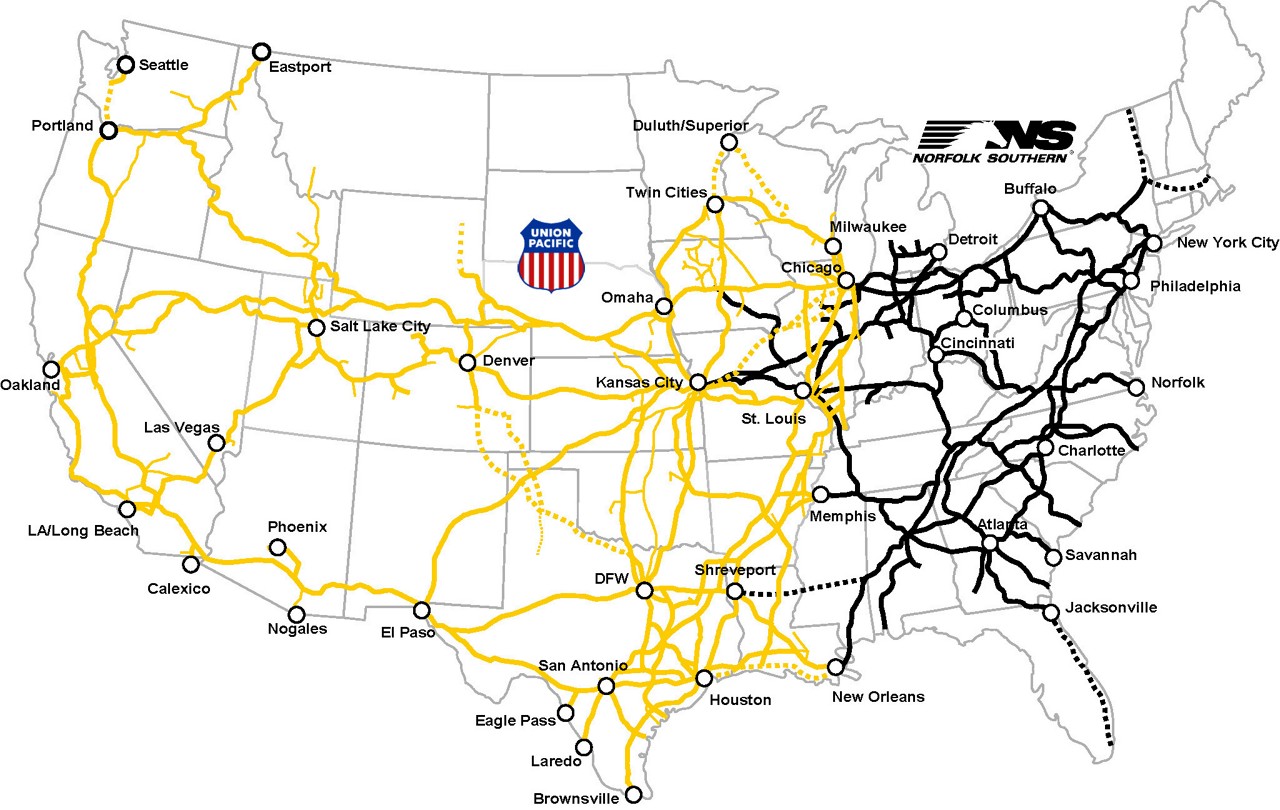
Source: Union Pacific
Increasing investment needs within the electricity utility sector have been a catalyst for several M&A transactions. US utilities Black Hills Corp and NorthWestern Energy recently announced a merger to create a $7.8 billion utility with higher earnings growth potential (the Earnings Per Share compound annual growth rate is forecast to increase from 4–6% to 5–7%). The transaction will also make it easier for the combined entity to meet the data centre‑driven demand for electricity currently seen in the US Mid‑Continent.
US natural gas utility Spire Inc has recently acquired Nashville’s gas utility for $2.5 billion (at 1.8x rate base or 24x Price/Earnings [P/E]) from Duke Energy. This transaction is among a growing trend of utilities with both electric and natural gas assets divesting their gas utilities to focus on the higher growth, electric segments of their business.
In the airports space, Brazilian infrastructure conglomerate Motiva Infraestrutura de Mobilidade is in the final stages of divesting its portfolio of 20 Latin American airports for around $2 billion. The most likely acquirers of these assets are existing global listed infrastructure airport operators from both Europe and Mexico.
In China, natural gas utility ENN Energy received a takeover bid from its parent company, ENN Natural Gas. This bid was priced at a 51% premium to its stock price. This transaction was driven by a continued weak operating environment, which forced the parent company to simplify its corporate structure, increase the integration of its different business segments and rationalise costs.
Lower energy prices and a slower growth outlook for Natural Gas Liquids (NGLs) have seen North American energy midstream companies Keyera, Kinder Morgan and ONEOK Inc each acquire assets that will help them to rationalise, optimise and consolidate their existing energy transportation and storage footprints.
Industry consolidation‑driven M&A generally results in lower customer bills, lower operating costs, higher asset utilisation, lower financing costs and stronger business models. We view this type of M&A as being good for customers, regulators, employees and shareholders.
Private market acquisitions
The second major M&A theme of 2025 for global listed infrastructure has been private market investors acquiring public companies (or their assets).
The year started with Canadian pension fund CDPQ bidding $2.1 billion for Innergex Renewable Energy’s portfolio of hydro, wind, solar and BESS assets in Canada, US, France and Chile. The acquisition price was at a 58% premium to the listed market or ~11.8x EV/EBITDA3. This transaction occurred as listed markets aggressively sold off renewable energy assets, following the election of President Trump.
In March, Blackstone Infrastructure made a $6.5 billion bid for US electric utility TXNM Energy at a 23% premium to its share price. This equated to multiples of 1.7x rate base or 18x P/E. TXNM believes that this bid fairly recognised the value of its existing business, and that a private market owner would be better able to finance its significant future capital investment program.
In July, TIL Group (a consortium consisting of BlackRock’s Global Infrastructure Partners, GIC and MSC) acquired the Altamira port in Mexico from listed toll road operator PINFRA for $800 million. The price equates to around 20x EV/EBITDA; a significant premium to listed market valuations of between 6x and 10x.
Port of Altamira – Mexico
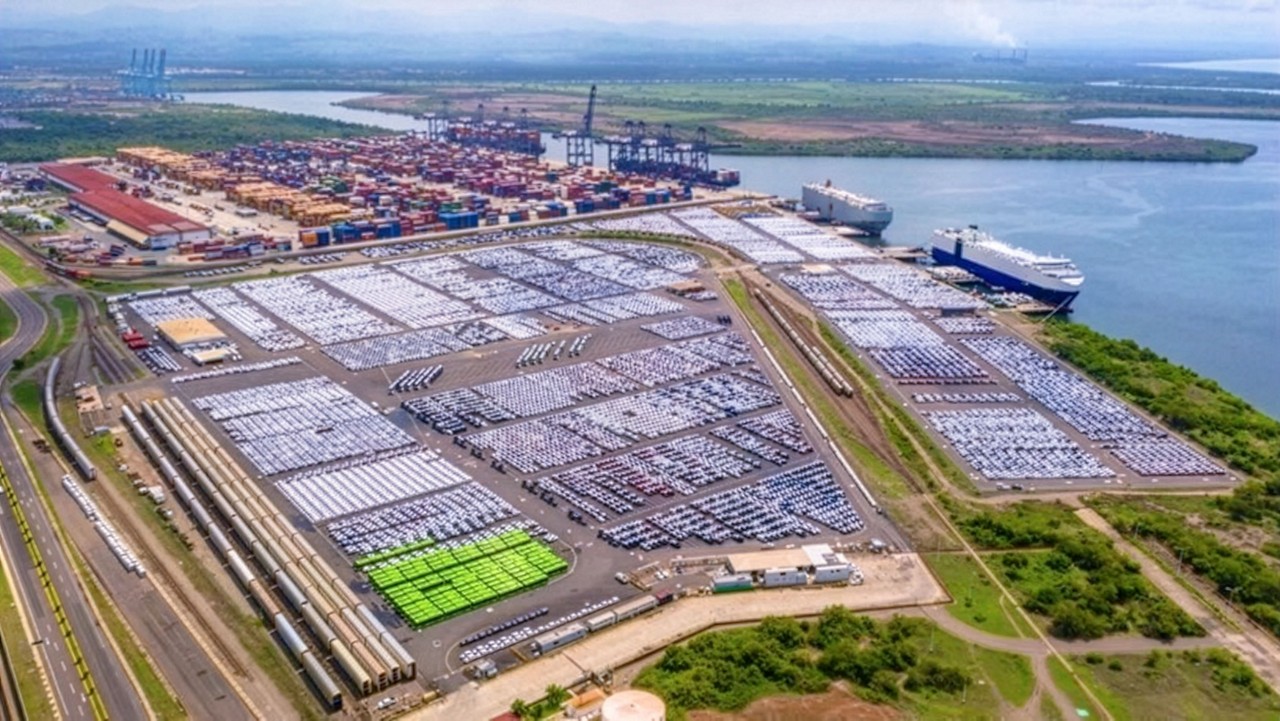
Source: Mexico Business News
Late July saw US listed digital infrastructure company Crown Castle sell its fibre and small cells businesses to EQT (and related companies) for $8.5 billion. This sale price was at the lower end of market expectations of $8 billion to $10 billion. These assets have been serial underperformers with Crown Castle unable to achieve attractive investment returns.
Also in July, Bloomberg reported that US renewable energy developer AES Corp was “exploring strategic options including a potential sale” after it had received takeover interest from large investment firms. Nothing has progressed publicly since. However, we believe there is a reasonable probability that AES will either divest assets to private market participants, or accept a “take‑private” bid, given the decline in renewable energy developers’ share prices over the last 12 months.
In August, private equity firm KKR signed a non‑binding letter of intent with Californian‑based utility Sempra to increase its stake (currently 20%) in Sempra Infrastructure, its Liquefied Natural Gas (LNG) business segment. Financial markets generally expect KKR to pay around 12–13x EV/EBITDA, which is a 20–30% premium over comparable listed LNG companies like Cheniere Energy. The benefits to Sempra from this transaction would be to reduce the conglomerate discount in its share price, improve its credit quality, reduce business risk and achieve price discovery on these complex, long‑dated assets.
August also saw mobile tower company SBA Communications sell its portfolio of 500 Canadian cell towers to CVC DIF for around $320 million. This equated to an AFFO multiple of “mid‑to‑upper twenties”, a strong outcome.
Low‑cost financing options
The third major M&A theme for global listed infrastructure in 2025 has been low‑cost financing options. The capital‑intensive nature of infrastructure means companies need to raise new equity to fund new investments. A rough rule of thumb is that between 30 and 40 cents of new equity is needed for every extra $1 of investment. As investment needs have increased – particularly related to rising electricity demand – global listed infrastructure companies have sought to divest assets or non‑core minority shareholdings to fund the equity portion of their expanded investment plans. The high prices achieved by these sales provide the selling companies with a lower cost of financing than would have been achieved by issuing new equity to the market.
January saw American Electric Power (AEP) divest a 20% shareholding in part of its electric transmission business to KKR and Canadian pension plan PSP Investments for $2.8 billion. This price represents a very healthy 2.3x rate base, or 33x PE. In the same month Eversource Energy announced the sale of its water utility for $2.4 billion, which equates to 1.7x rate base.
AEP electric transmission assets
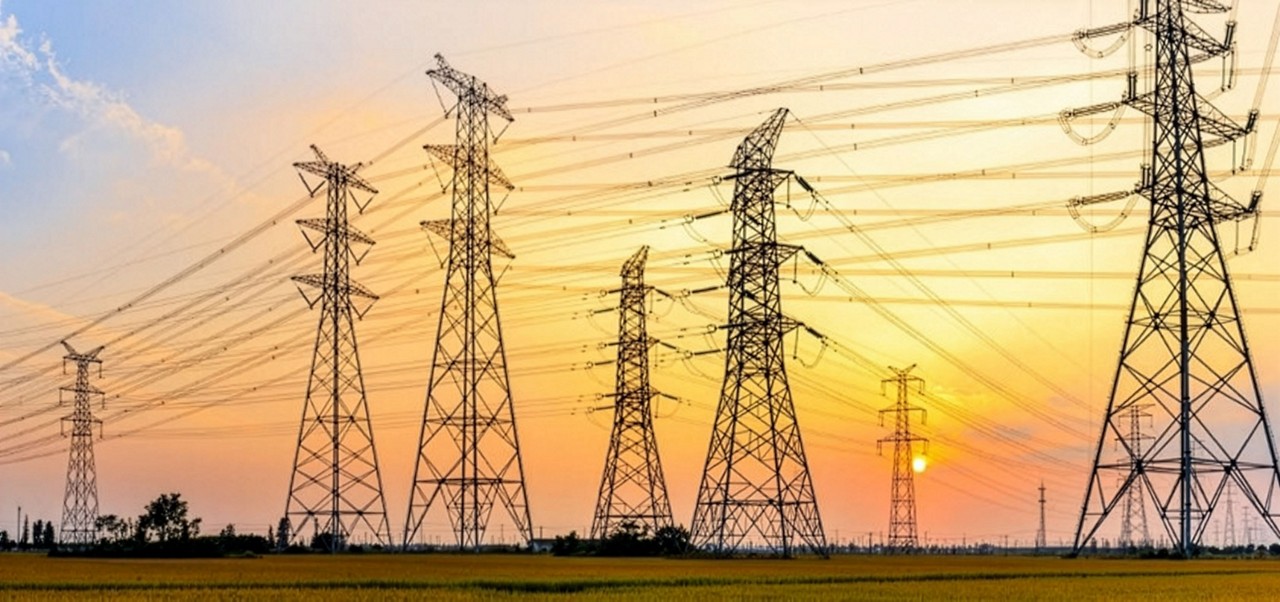
Source: Transmission Hub
In May, US electric and gas utility CenterPoint Energy announced it was starting the sale process for its Ohio natural gas utility. These proceeds will to be used to fund future investment into higher growth, higher return and low risk electric assets in Texas.
In August, US electric utility Duke Energy announced it was selling a 20% stake in its Florida subsidiary to Brookfield’s Super‑Core Infrastructure strategy for $6 billion. The price achieved was a very strong 2x rate base, or 29x PE.
All four of these asset sales were carried out to assist with the financing of large and growing investment plans. Quite simply: divesting assets at prices above your current share price provides a lower cost of capital, which in turn benefits customers and shareholders.
M&A premiums paid for global listed infrastructure
The below chart illustrates the premiums at which these M&A transactions have been carried out, relative to our estimate of the respective undisturbed, listed market valuations. The average premium to listed market valuations in 2025 has been 43%. However, the range of outcomes has been wide, from very high premiums for PINFRA’s Altamira port and AEP’s electric transmission assets to a low premium (almost a merger‑of‑equals) between Black Hills Corp and Northwestern Energy.
M&A premium paid to listed market valuations
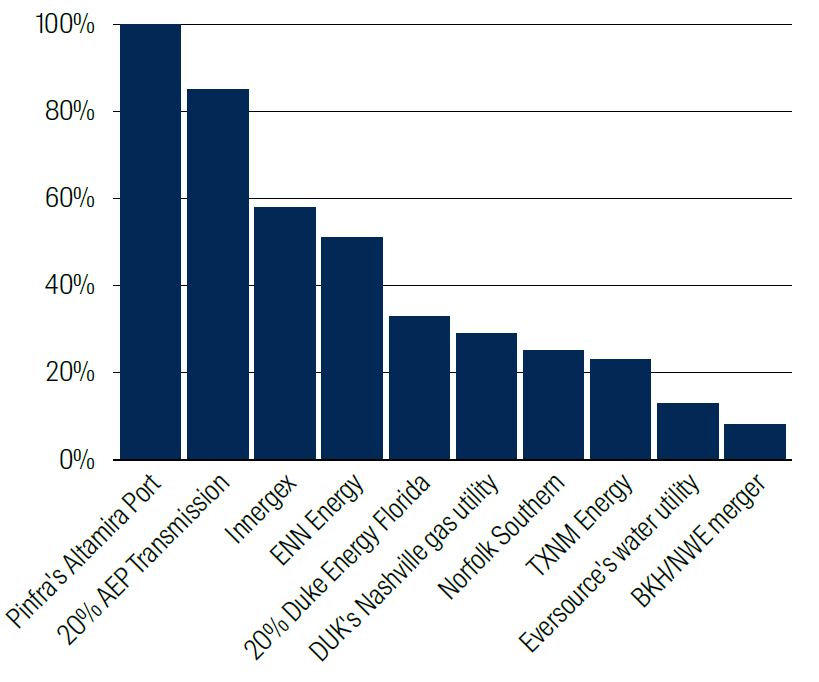
Source: First Sentier Investors and company reports
The M&A outlook going into 2026
Optimistic financial markets, a pro‑business US administration, strong demand for infrastructure assets and increased financing needs for global listed infrastructure investment programs all point towards a robust M&A market moving into 2026.
First, we expect progress in already‑announced deals:
- Brazil’s Motiva to successfully conclude the sale of its portfolio of 20 airports by year‑end
- KKR to acquire a 30% plus stake in Sempra’s LNG division and
- CenterPoint Energy to achieve a strong price for its Ohio natural gas LDC in either the December quarter of 2025 or early in 2026.
Second, we expect industry consolidation M&A to accelerate as smaller electric utilities struggle to finance significantly higher capital investment needs and electric utilities seek to divest non‑core gas utilities. We also expect that BNSF Railway will follow Union Pacific to create a transcontinental railroad by acquiring CSX Corp (albeit this could be a 2027 event).
Third, we anticipate that mispricing in public markets will continue to create opportunities for private market M&A transactions. Areas of public market pricing pessimism around renewable energy (AES Corp, XPLR Infrastructure, Portland General Electric), toll roads (Atlas Arteria, Motiva, PINFRA) and passenger rail (Getlink) in particular, create potential for these events through 2026. We would also note that BlackRock’s October 2024 acquisition of Global Infrastructure Partners (GIP) is likely to ramp up private market fundraising, with listed markets likely to provide many of the infrastructure assets for this new mega infrastructure fund manager. We expect this will be met with a competitive response from fellow mega managers Blackstone, Brookfield, KKR and Macquarie.
Sempra Infrastructure’s Cameron LNG Export Terminal
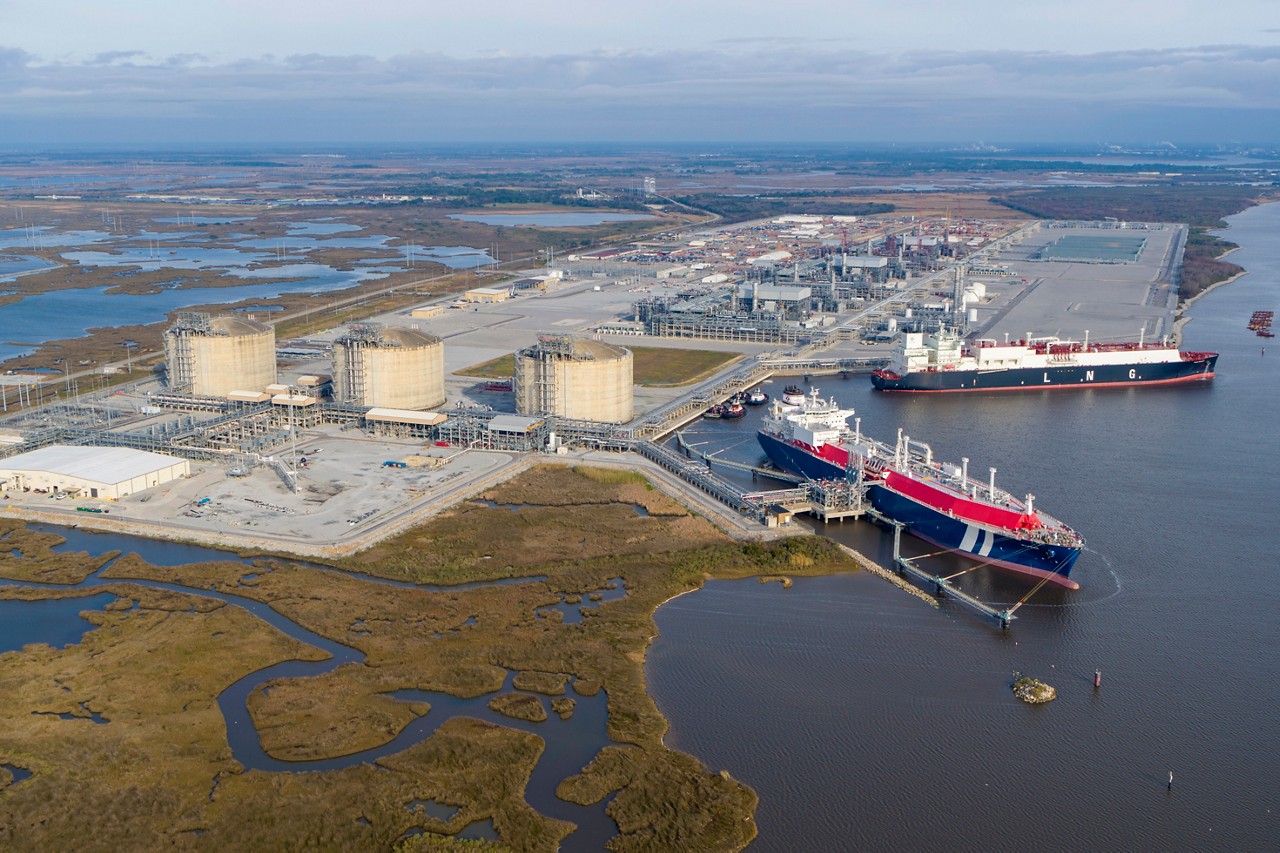
Source: Sempra
What we haven’t yet seen in 2025 is M&A centred around corporate restructurings ie transactions seeking to unlock trapped assets or to remove conglomerate discounts within global listed infrastructure companies.
We believe property assets are ignored and trapped inside several global listed infrastructure firms including East Japan Railway, West Japan Railway, Zurich Airport and Tokyo Gas. Indian airports are ignored or lowly valued in Groupe ADP and Zurich Airport. UGI Corp is a US natural gas conglomerate which trades at a discount to our estimate of intrinsic value, owing to its eclectic mix of gas utilities, energy midstream, propane and Renewable Natural Gas (RNG). We believe that some of the above‑mentioned restructuring opportunities will be actioned over the next 18 months, creating more focused companies which are easier to value and are then likely to trade at higher multiples – to the benefit of customers, employees and shareholders.
Conclusion
M&A activity within the global listed infrastructure asset class has been robust throughout 2025. This has been driven by industry consolidation, private market acquisitions and low‑cost financing options. The average M&A premium paid in these transactions has been 43% above our estimate of listed market valuations.
As we move towards 2026, we expect these themes to continue with the potential for the emergence of a fourth driver, namely corporate restructurings. In general, we believe M&A within the global listed infrastructure asset class provides positive outcomes for all stakeholders – customers, regulators, employees and shareholders.
Source: First Sentier Investors, company data, as of 31 August 2025
1 All figures in USD unless otherwise stated.
2 The takeover price represents a 44% premium to Norfolk Southern’s share price before the publication of an article in Trains magazine where Union Pacific discussed the potential for railroad M&A.
3 Enterprise Value/Earnings Before Interest, Taxes, Depreciation and Amortisation
Read our latest insights
Important Information
This material is for general information purposes only. It does not constitute investment or financial advice and does not take into account any specific investment objectives, financial situation or needs. This is not an offer to provide asset management services, is not a recommendation or an offer or solicitation to buy, hold or sell any security or to execute any agreement for portfolio management or investment advisory services and this material has not been prepared in connection with any such offer. Before making any investment decision you should consider, with the assistance of a financial advisor, your individual investment needs, objectives and financial situation.
We have taken reasonable care to ensure that this material is accurate, current, and complete and fit for its intended purpose and audience as at the date of publication. No assurance is given or liability accepted regarding the accuracy, validity or completeness of this material and we do not undertake to update it in future if circumstances change.
To the extent this material contains any expression of opinion or forward‑looking statements, such opinions and statements are based on assumptions, matters and sources believed to be true and reliable at the time of publication only. This material reflects the views of the individual writers only. Those views may change, may not prove to be valid and may not reflect the views of everyone at First Sentier Group.
About First Sentier Group
References to ‘we’, ‘us’ or ‘our’ are references to First Sentier Group, a global asset management business which is ultimately owned by Mitsubishi UFJ Financial Group. Certain of our investment teams operate under the trading names AlbaCore Capital Group, First Sentier Investors, FSSA Investment Managers, Stewart Investors, RQI Investors and Igneo Infrastructure Partners, all of which are part of the First Sentier Group. RQI branded strategies, investment products and services are not available in Germany.
We communicate and conduct business through different legal entities in different locations. This material is communicated in:
- Australia and New Zealand by First Sentier Investors (Australia) IM Ltd, authorised and regulated in Australia by the Australian Securities and Investments Commission (AFSL 289017; ABN 89 114 194311)
- European Economic Area by First Sentier Investors (Ireland) Limited, authorised and regulated in Ireland by the Central Bank of Ireland (CBI reg no. C182306; reg office 70 Sir John Rogerson’s Quay, Dublin 2, Ireland; reg company no. 629188)
- Hong Kong by First Sentier Investors (Hong Kong) Limited and has not been reviewed by the Securities & Futures Commission in Hong Kong. First Sentier Group, First Sentier Investors, FSSA Investment Managers, Stewart Investors, RQI Investors and Igneo Infrastructure Partners are the business names of First Sentier Investors (Hong Kong) Limited.
- Singapore by First Sentier Investors (Singapore) (reg company no. 196900420D) and this advertisement or material has not been reviewed by the Monetary Authority of Singapore. First Sentier Group (registration number 53507290B), First Sentier Investors (registration number 53236800B), FSSA Investment Managers (registration number 53314080C), Stewart Investors (registration number 53310114W), RQI Investors (registration number 53472532E) and Igneo Infrastructure Partners (registration number 53447928J) are the business names of First Sentier Investors (Singapore).
- United Kingdom by First Sentier Investors (UK) Funds Limited, authorised and regulated by the Financial Conduct Authority (reg. no. 2294743; reg office Finsbury Circus House, 15 Finsbury Circus, London EC2M 7EB)
- United States by First Sentier Investors (US) LLC, registered with the Securities Exchange Commission (SEC# 801‑93167)
- other jurisdictions, where this document may lawfully be issued, by First Sentier Investors International IM Limited, authorised and regulated in the UK by the Financial Conduct Authority (FCA ref no. 122512; Registered office: 23 St. Andrew Square, Edinburgh, EH2 1BB; Company no. SC079063).
To the extent permitted by law, MUFG and its subsidiaries are not liable for any loss or damage as a result of reliance on any statement or information contained in this document. Neither MUFG nor any of its subsidiaries guarantee the performance of any investment products referred to in this document or the repayment of capital. Any investments referred to are not deposits or other liabilities of MUFG or its subsidiaries, and are subject to investment risk, including loss of income and capital invested.
© First Sentier Group
Get the right experience for you
Your location :  Australia
Australia
Australia & NZ
-
 Australia
Australia -
 New Zealand
New Zealand
Asia
-
 Hong Kong (English)
Hong Kong (English) -
 Hong Kong (Chinese)
Hong Kong (Chinese) -
 Singapore
Singapore -
 Japan
Japan
















 United Kingdom
United Kingdom 